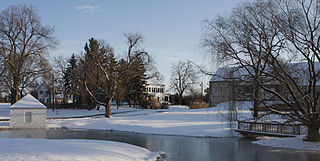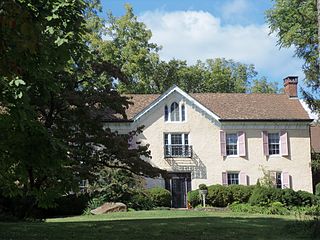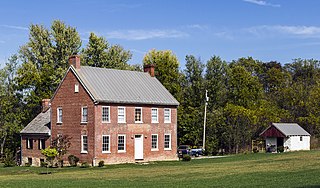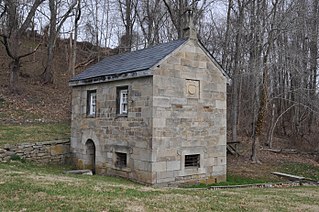
The Nallin Farm House and the related Nallin Farm Springhouse and Bank Barn are located on Fort Detrick at Frederick, Maryland.

Clover Hill is a historic home located at Brookeville, Montgomery County, Maryland, United States. It is a large, 2+1⁄2-story, five bay Italianate-style residence principally built about 1857, with evidence of several earlier building campaigns, including a log dwelling from the mid 18th century. The ruins of a large bank barn and a stone springhouse stand on the property. The house was built by Ephraim Gaither, a Maryland legislator (1817–1820) and locally prominent citizen.
The Henry Nelson House is a historic home and farm complex located at New Market, Frederick County, Maryland, United States. It is a 2+1⁄2-story, coursed stone rubble house built in about 1800, with a gable roof, and a corbeled brick cornice. Outbuildings include a barn, log springhouse, and a small log house.

The George Markell Farmstead, also known as Arcadian Dairy Farm and the Thomas Property, is a historic home and farm complex located at Frederick, Frederick County, Maryland, United States. It consists of brick house built about 1865, a brick smokehouse, a bake oven, two stone domestic outbuildings, an ice house, a springhouse, a frame stable, a frame chicken house, a mid-20th century guest house, and various sheds and outbuildings. Nearby is a large gambrel-roofed concrete block barn. The main house has combined Greek Revival and Italianate stylistic influences. The once large Markell dairy farm, with its lane to the Ballenger Creek ford of the Monocacy River, served as the primary approach route to the battlefield by Confederate troops during the July 9, 1864 Battle of Monocacy during the American Civil War.

Harris Farm is a historic home and farm complex located at Walkersville, Frederick County, Maryland, United States. The main house was built in 1855, and is a three-story center plan house in predominantly late Greek Revival syle, with some Italianate elements. The agricultural complex consists of a bank barn with an attached granary; a second frame barn that shares an animal yard with the bank barn; a row of frame outbuildings including a converted garage, a workshop, and a chicken house. There is also a drive-through double corn crib; and a frame pig pen from 1914. The 20th-century buildings consist of a frame poultry house, a dairy barn with milk house and two silos, and an octagonal chicken coop. A lime kiln is located on the edge of the property. The property is preserved as part of the Walkersville Heritage Farm Park.
Kitterman–Buckey Farm is a historic home and farm complex located at Johnsville, Frederick County, Maryland. It is the remnant of the farm that was established by the German immigrant Christopher Kitterman in 1752, and which remained in the Root/Buckey family from 1790 to 1919. The main house was built about 1752 and is two stories in height. It is composed of two halves, built probably 40 to 50 years apart, and united under a low-sloping slate roof with three chimneys, with additions made in the 19th century and again in the 1950s and 1980s. Also on the property are a springhouse and cabin / smokehouse both dating to about 1752, a machine shed, horse barn built about 1930, a bank barn built about 1850, and a silo from 1934.

Lewis Mill Complex is a historic grist mill complex located at Jefferson, Frederick County, Maryland. The complex consists of seven standing structures, a house foundation, and the remains of an earlier millrace. It centers on an early 19th-century three-story brick mill structure with a gabled roof. The mill complex served German immigrant farmers in Middletown Valley between 1810 and the 1920s. It was rehabilitated in 1979-1980 for use as a pottery shop. Also in the complex are a stuccoed log house and log springhouse built about; a frame wagon shed and corn crib structure and frame barn dating from the late 19th century; and early 20th century cattle shelter and a frame garage.

Ditto Knolls is a historic home and farm located near Hagerstown, Washington County, Maryland, United States. It was built about 1790, and is a five-bay, two-story brick house with a two-bay, one-story brick rear wing. It features a one-story entrance porch supported by Doric columns. Also on the property is a large stone bank barn and springhouse. It is one of two historic farm complexes located in Ditto Farm Regional Park, along with the Henry McCauley Farm.
Wilson–Miller Farm is a historic home and farm located near Sharpsburg, Washington County, Maryland, United States. The house is a two-story, two-part, eight-bay log building resting on fieldstone foundations. The house features three brick chimneys, each painted red. Outbuildings include a one-story stone springhouse and a frame bank barn.

Hoffman Farm is a historic farm complex located at Keedysville, Washington County, Maryland, United States. It consists of an 1840s Greek Revival style two-story brick dwelling, adjacent brick slave quarters, a Federal-style stone house built about 1810 over a spring, a frame wagon shed, a log hog barn, and a frame forebay bank barn. The farm buildings were used as a hospital during the American Civil War in Battle of Antietam from the day of the battle on September 17, 1862, and through the following month. Over 800 men were hospitalized in the barn, house, outbuildings, and grounds.
Snively Farm is a historic home and farm located near Eakles Mills, Washington County, Maryland, United States. It is a two-story, three-bay 18th century log structure with an exposed basement at the front elevation on fieldstone foundations. The home features a two-story, three-bay rear addition built in the late 18th or early 19th century with a one-story, two-bay stone kitchen. The property includes a stone springhouse and a frame butchering or outkitchen with a massive stone exterior chimney.

Springfield Farm is a historic home and farm located at Williamsport, Washington County, Maryland, United States. It was built in three distinct parts, with the center, or original section, dating from the second half of the 18th century. This two-story plus attic beaded clapboard house is five bays wide with an entrance in the center bay of both the first and second stories on the east façade. The property includes a springhouse and stillhouse both of rough fieldstone, and several smaller buildings. It was a home of Revolutionary War General Otho Holland Williams (1749-1794).

The Willows is a historic farm complex located at Cavetown, Washington County, Maryland, United States. The farmhouse is a four bay long two-story Federal brick structure that is painted white. Also on the property are a one-story stone springhouse; a log pig house; a brick necessary; a stone smokehouse; "the old house," a former slave quarters; and two frame barns.
Nicodemus Mill Complex is a historic home and mill complex located at Keedysville, Washington County, Maryland, United States. It consists of a dated 1810 2+1⁄2-story, five-bay stone house with a mid-19th-century brick service wing, the ruins of a grist mill built about 1829, and an extensive complement of 19th-century domestic and agricultural outbuildings including a stone springhouse, stone-end bank barn, brick out kitchen, frame wash house, and a stuccoed stone secondary dwelling. It is an intact representative example of the type of farmstead characteristic of the region during the 19th century.
Norris-Stirling House, also known as Mt. Pleasant, is a historic home located at Bel Air, Harford County, Maryland. It is composed of an early 19th-century fieldstone section and two later frame additions. In 1936, a lean-to addition and double-tiered porch were added. The property also includes a large frame bank barn and corncrib, a stone springhouse, and a garage.

D. H. Springhouse is a historic springhouse located at Bel Air, Harford County, Maryland. It is a little gray stone building set into the base of a steep hill. This is a stone springhouse with a schoolroom above, 16.5 feet by 23 feet, with one narrow wall set into the bank over several fresh springs. It was built about 1816, and the quality of stonemasonry is notable.

The Englar-Schweigart-Rinehart Farm is a historic home and farm complex located at Westminster, Carroll County, Maryland, United States. It consists of a brick house, a brick smokehouse, a stone springhouse, a frame bank barn, and a frame poultry house. The house is a two-story, five-by-two-bay Flemish bond brick structure painted white, and set on a rubble stone foundation. The house was constructed in 1809 or 1810. The farm is significant for its illustration of how German-Swiss immigrants to Maryland became acculturated to the dominant English culture.
Keefer–Brubaker Farm, also known as the Oscar Fogle Farm, is a historic home and farm complex located at Taneytown, Carroll County, Maryland. It consists of a two-story six-by-two-bay log-and-frame house which is partially encased in brick and rests on a rubble stone foundation Also on the property is a frame summer kitchen, a combination smokehouse/dry house, a frame springhouse, a shop building, a bank barn, a dairy, a hog pen, a tool shed, poultry house, and several more recent buildings. It is a representative example of a family farm complex which spans the period from the late 18th century to the mid 20th century.

Rockland Farm is a historic home and farm complex located at Westminster, Carroll County, Maryland, United States. The complex consists of a brick house, the stone foundation of an 18th-century springhouse, as well as a large frame barn and a corn crib, both dating to the late 19th century. The house, built in 1795, retains the Pennsylvania German traditional three-room plan with a central chimney. It is a two-story, three-bay by two-bay brick structure on a stone foundation built into a slope.

Jerusalem Mill Village is a living history museum that spans the 18th through early 20th centuries. One of the oldest and most intact mill villages in the U.S. state of Maryland, Jerusalem is located in Harford County, along the Little Gunpowder Falls River. It also serves as the headquarters of the Gunpowder Falls State Park. The site was added to the National Register of Historic Places on August 20, 1987. Also on the National Register of Historic Places and located nearby are Jericho Farm and the Jericho Covered Bridge.

















